Leonardo da Vinci was highly curious about the natural world, as well as modern engineering, and his Ornithopter designs attempted to marry these two subjects together.
Introduction
Leonardo's notebooks featured thousands of study sketches, often of the human anatomy, but also of birds and other animals. He was interested in many wonders of the natural world, such as bird flight, and the flow of rivers. He had a desire to create inventions that could benefit humanity, and realised that he would have to understand nature in order to produce the most intelligent designs.
Leonardo da Vinci's Ornithopter, just one of his many flying machine designs, attempted to create human flight based on the inspiration of birds. Leonardo would sit and study the methods with which birds would keep themselves airborne, and then attempt to replicate this in the human form.
The inventor realised through his studies that generating enough power to keep a human airborne using flapping wings was virtually impossible at that time in the evolution of engineering, and after much thought he would decide to try an alternative approach. By this stage Da Vinci had developed an in-depth understanding of bird flight, leaving behind huge number of sketches, notes and musings about their own behaviour.
Of Da Vinci's alternative approaches to simply flapping one's arms, he attempted to put together a series of pdeals and pulleys, with the human lying flat and activating wings via this more complex system. It was hoped that engineering might be able to scale up the natural strength of humans, to generate enough force to keep the Ornithopter in flight.
Once it became clear that even this approach was doomed to failure, and probably injury in any testing scenarios, Da Vinci started to examine birds in their most efficient forms, when gliding through the air. That helped him to move towards modern-day gliders, as an alternative approach. This was much more likely to succeed, but he was also limited by the materials of the period, which were much heavier than those available today.
Da Vinci's ornithopter invention provides another reminder of how an engineer can have a massive impact, without their designs even necessarily "working". By simply progressing their theories, and documenting all of their findings, it would often help future generations to solve the save mystery, potentially by taking advantage of opportunities that weren't available originally.
Leonardo remains most famous for his paintings, and for many centuries this was all he was known for. In more recent times, however, a more rounded view of his life and career has formed, thanks to a thorough study of his many notes and drawings, bringing his achievements in engineering to the forefront for the first time.
This article examines Leonardo da Vinci's Ornithopter designs in detail. We consider whether they could ever realistically have worked, but also how his own findings may have helped other engineers and inventors of future generations. We discuss Da Vinci's practices as a scientist, and how he used sound logic to examine different ideas.
Table of Contents
- Introduction
- What is an Ornithopter?
- Da Vinci's Bird Studies
- Leonardo's Ornithopter Inventions
- Did Da Vinci ever fly his Ornithopter invention?
- What is the Meaning of Ornithopter?
- What is the History of the Ornithopter?
- References
What is an Ornithopter?
An Ornithopter is a type of aircraft which replicates a bird or insect flapping its wings in order to stay airborne. Some ornithopter designs have included crews and engines in order to overcome the problems of generating sufficient power to succeed against the gravitational pull.
Da Vinci's Bird Studies
Leonardo da Vinci studied the flight of birds in extraordinary detail, leaving behind over 500 drawings in which he examined the methods in which they generated such power, and also how they maintained flight in an efficient manner. The artist initially created entertaining theatre props in which wings would flex in a relatively crude manner, but this gave him inspiration for the more detailed analysis that would follow years later.
His powers of observation, which laid behind his strengths as a portrait painter, in which he could spot the most subtle of details in human and animal anatomy, would be crucial in his bird studies. He soon recognised the impact of wind speed and direction on a bird's behaviour, and also how different types of bird would handle flight in slightly different ways.
Da Vinci was always curious about the inner workings of anatomy, and with birds he would study how the head, tail and wings would interact with each other. One can see the connection to modern airplanes, with wings and the tail being replicated in a similar manner by modern engineering practices. Da Vinci advanced to the stage of understanding the flow of air across the bird, just as he had studied the flow of water within canal systems, rivers and during natural disasters.
The artist would focus on the themes of bird and human flight between the years of 1485 and 1515. It is generally considered that Da Vinci's biggest contribution was in the discovery of the existing issues which made human flight impossible. He therefore handed the gauntlet on to the next generation to solve these problems, but with a much clear understanding on what was holding humanity back in terms of producing workable ornithopters.
The scale of these issues is underlined by the fact that it was not until around the 20th century that these mysteries would be solved, and even then the ornithopter is considered unworkable within the commercial environment.
Besides his strong focus on birds, Leonardo also spent considerable time analysing other animals, with horses being the most common. He also covered bears and dogs, as well as some mythical creatures. Over time he would desire even more knowledge, delving deeper into the anatomy of humans and animals, starting to map out their inner functions and helping to evolve scientific understanding of how we all work.
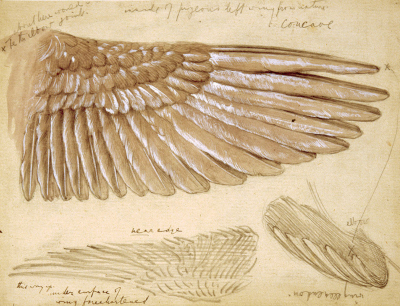
Wing Studies
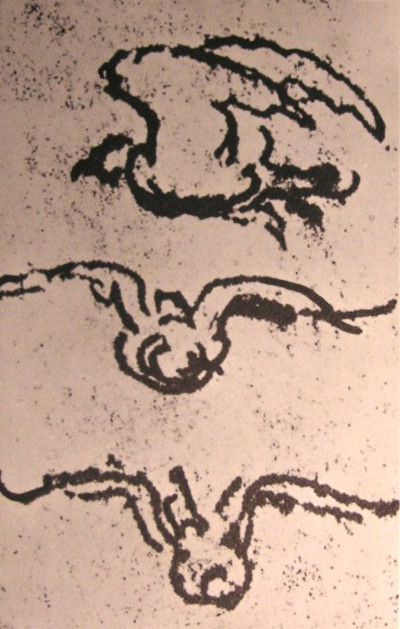
Bird Flight
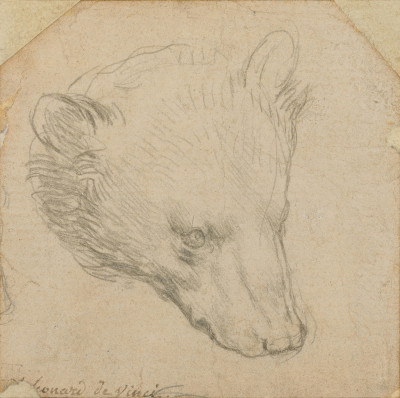
Head of a Bear
Leonardo's Ornithopter Inventions
Da Vinci initially attempted to replicate the action of flapping wings purely by attaching wings to human arms in a fairly crude design. He quickly realised that this alone would not work, and so he sought ways of multiplying human strength through a variety of means. Eventually, a series of levers and pulleys could be activated by the pilot's legs, but this meant the head would need to be used to steer the aircraft.
Da Vinci's invention evolved over several decades, as he pinpointed engineering challenges and attempted new methods that could overcome them. He tried out ideas where the pilot would lay flat, and others where they were upright. All of these were documented within his many notes and drawings which eventually would be studied in full by art historians of from later centuries.
Whilst Da Vinci would understand the concepts around flight and air movement with regards birds, there were still considerable flaws in his designs. He also faced the more significant challenge of materials of the time being heavy, forcing him to find ever more elaborate means to generating sufficient power to keep the pilot airbourne.
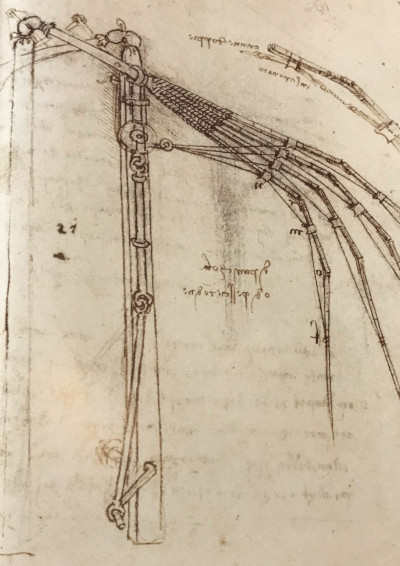
Ornithopter in Action, 1486-1490
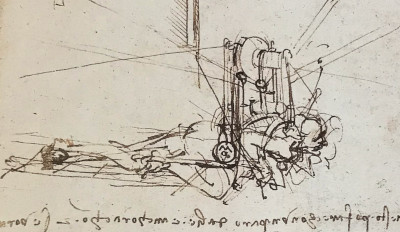
Studies of an Ornithopter with a Hand and Foot-Powered Mechanism 1487-1490

Studies of Wing Articulation 1487-1490
As his career progressed, Da Vinci would start to move away from the traditional idea of an ornithopter, as he finally started to accept that the issues he faced could not realistically be overcome. He therefore started to think more towards a glider and also parachutes as alternatives. He also started to design methods of coping with a heavy landing, essentially an early form of air bag, demonstrating his lack of confidence in the strength of his earlier designs.
Despite his passion and commitment to helping humans to fly, Leonardo would ultimately run out of time within his career to solve many of the challenges that he came across when trying to design an effective ornithopter. However, even in just highlighting the problems that he found, and putting forward some early potential solutions, he was able to inspire engineers and inventors from later generations who took his work and evolved it yet further.
Whilst investing considerable amounts of time in producing a flying machine, Da Vinci also looked into other engineering challenges that inspired him. He was encouraged by his donors to innovate for the military, in order to give his region of Italy a competitive edge and he also looked in to diving suits, helping humans to investigate deep oceans, as well as the skies that had otherwise occupied his attentions.
Did Da Vinci ever fly his Ornithopter invention?
Sadly, it is not believed that Leonardo Da Vinci ever flew his ornithopters. There are some accounts, perhaps more legends, that speak of how an assistant would attempt a flight but fall, injuring themself in the process, but these are not believed by most respected historians to be true.
It is likely that Leonardo realised the issues with his inventions, and wanted to continue to develop his ideas rather than risking injury or embarrassment by producing an early model for testing. Successful ornithopter have been developed more recently, however, some of which would have been inspired by Leonardo's own studies.
What is the Meaning of Ornithopter?
Ornithopter, a term which means an aircraft which maintains flight through the flapping of wing-like elements, is derived from ancient Greek, being a merge of 'ornith' for bird and 'pteron' for wings. It is a term still used today, even though flight engineering techniques have evolved considerably.
What is the History of the Ornithopter?
Leonardo was not the first to come up with the idea of an aircraft which could mimic bird flight through the flapping of wings. Indeed, it was many centuries earlier that the idea was first investigated, as far as we can tell. A medieval monk, Elmer of Malmesbury, made an attempt towards human flight in the 11th century and many similar theories had been thrown about even before that.
Humans had long marvelled at the beauty and elegance of birds, as well as the sky above, and wanted to become a part of this themselves. Sadly, it would take many centuries and failures before successful human flight would be achieved. During Da Vinci's period, despite following sound scientific procedures of investigation, the available materials of that time would have made it virtually impossible to produce a working prototype of an Ornithopter.
The earliest workable prototypes would not appear until the late 19th century in France. These were relatively small designs, less ambitious than Da Vinci's, but also more likely to succeed. Over the next few decades some of these ideas would be refined and new ideas added, such as alternative methods of generating power.
It would be in the early 20th century that the first Ornithopters that were capable of carrying humans would appear. Many of these required engines in order to generate enough power to stay airborne for an extended period of time. Ultimately, it seemed that Da Vinci's issues could never be resolved, in terms of physical exertion alone keeping an Ornithopter in air.
By the 21st century this ambition was finally realised, albeit in ways that could not be used commercially. Several successful flights have been achieved, with humans airborne, powering their flight through a series of flapping wings. Many accidents have occurred, however, ensuring that workable ornithopter are still a dangerous proposition.
The majority of successful alternatives to Da Vinci's original inventions have relied both on modern materials, which are much lighter, but also on newer technologies such as jet-propelled power, none of which were available to the famous Renaissance Man at the time that he attempted the feat himself.
References
- Leonardo. The Complete Paintings and Drawings, Frank Zöllner & Johannes Nathan, Taschen
- Leonardo da Vinci, Walter Isaacson




